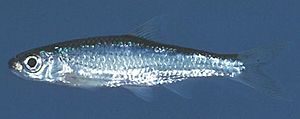Popeye shiner facts for kids
Quick facts for kids Popeye shiner |
|
|---|---|
 |
|
| Conservation status | |
| Scientific classification | |
| Synonyms | |
|
Photogenis ariommus Cope, 1867 |
The popeye shiner (Notropis ariommus) is a small, freshwater fish found in North America. It belongs to the minnow family. This fish gets its name from its noticeably large eyes.
Contents
Where the Popeye Shiner Lives
The popeye shiner lives in the United States. You can find it mainly in the Ohio River basin and the Tennessee River drainage. This includes states like Alabama, Georgia, Indiana, Kentucky, Ohio, Pennsylvania, Tennessee, and West Virginia.
Some specific places where they live are the Tennessee River in Alabama and Georgia. They also live in the Wabash River in Indiana. In West Virginia, they can be found in the Cheat River and New River. Interestingly, the Kanawha River population is not native to that area.
For a long time, between 1894 and 1949, very few popeye shiners were seen. Only three were officially identified. But later, their numbers started to grow. They even appeared in places where they hadn't been seen before.
What Popeye Shiners Eat and Where They Live
Popeye shiners are insectivores, meaning they eat insects. They mostly munch on aquatic insects that live in the water. Their diet includes tiny midges, caddisflies, mayflies, and beetles.
These fish are called benthopelagic. This means they live near the bottom of the water but can also swim in the open water. They prefer temperate waters, which are not too hot or too cold. They like large creeks and small rivers that are super clear. The bottom of these waters usually has lots of gravel. The water flow in these places is typically slow to moderate, not too fast.
Dangers to Their Home
The clear water and specific flow that popeye shiners need make it hard for them to survive. If their clear water gets dirty, it can harm them. Things like factories and farming can cause problems.
When there's more runoff from farms, it can lead to sedimentation and siltation. This means dirt and mud get washed into the rivers. Over time, this makes the water cloudy and fills up the gravel bottoms. This creates a bad home for the popeye shiner, and their numbers can go down. Pollution is another big problem that destroys their habitat. Because popeye shiners live in smaller streams, they might face more of these negative impacts than other fish.
The speed of the water flow is also important. Popeye shiners need slow or moderately flowing rivers. Building dams for industry can change how fast the water flows. Just like too much silt, changed water flow can make rivers unsuitable for these fish.
Popeye Shiner Life Cycle
These minnows lay their eggs in the spring or summer. Not much else is known about how they live their lives. Scientists are still learning about them.
Protecting the Popeye Shiner
Some states are worried about the popeye shiner. Georgia and Ohio list them as endangered. In Indiana, they are considered "extirpated," which means they no longer exist there. This might be because their homes are being destroyed. Things like logging, building dams, and strip mining continue to happen.
Threats to Their Survival
A major threat to popeye shiners is new fish species moving into their waters. These are called exotic or invasive species. For example, in Indiana, three types of Asian carp—grass carp (Ctenopharyngodon idella), bighead carp (Hypothalmichthys nobilis), and silver carp (Hypothalmichthys molitrix)—likely caused the popeye shiner to disappear completely from that state.
Helping the Popeye Shiner
Not a lot is being done to protect the popeye shiner specifically. However, Ohio has a program to help. It's called the Division of Wildlife's Stream Conservation Program. This program works to protect and restore stream habitats. It focuses on native species that are endangered or threatened. The goal is to count and keep track of species that need the most conservation help.
See also
 In Spanish: Notropis ariommus para niños
In Spanish: Notropis ariommus para niños


